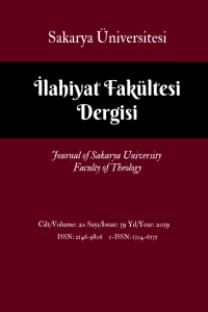الإ یقِاعَ فِي القرُآنِ وأَشَكْاَلھَُ - Kur’ân’da Ritim ve Şekilleri
Arap Dili ve Belagatı, Kur’ân’da Ritim, Peformanslar, Ritim Formları
Rhythm in the Qur'ān and its Forms
___
- el-Askerî, Ebû Hilâl Hasan b. Abdullah b.Sehl. Kitâbu's-Sınaateyn el-Kitâbe ve'ş-Şi'r.Y.Y. Daru İhyâi'l-Kütubu'l-'Arabî - İsa el-Bali el-Halebî ve Şurekauhu, 1. Basım, 1952.
- el-Antakî, Muhammed. el-Muhît fî esvâti’l-Arabiyye ve nahviha ve sarfiha. Beyrut: Daru’ş-Şarki’l-Arabî, 4. Basım, 1971.
- el-Bakıllânî, Muhammed b. Ebû Bekr. İ'câzu'l-Kur'ân. Kahire: Daru'l-Meârif, 1954.
- el-Baki, Naîm. "Fevâdi Teşkîli'l-Nağm fî Mûsîka'l-Kur'ân". Mecelletu't-Turasi'l-'Arabî 15-16. (1984).
- el-Cürcânî, Abdulkahir b. Abdurrahman b. Muhammed. Delâilu'l i'câz. thk. Muhammed Rıdvan ed-Daye - Muhammed Fayiz Daye. Şam: Daru'l-Feniyye, 1983.
- Dıraz, Muhammed Abdul azîm. en-Nebeu'l-'Azîm (Nazariyyat Cedîyde fî'l-Kur'ân).Y.Y. Daru'l-Kalem, c.6, 1984.
- Ebû Dîb, Kemal. Fî'l-bünyeti'l-îkaiyye li'ş-şi'ri'l Arabî. Beyrut: Daru'l-ilm li'l-Melâyin, 1. Basım, 1974.
- Enis, İbrahim. Delâletu’l-elfâz. Kahire: Mektebetu’l-Anglo el-Mısriyye, 6. Basım, 1991.
- Enis, İbrahim. Mûsika’ş-şiir. Kahire: Mektebetu’l-Anglo el-Mısriyye, 5. Basım, 1981.
- Fadl, Salah. Belâgatu’l-hitab ve ‘ilmu’n-nâs. Kuveyt: el-Meclisu’l-Vatanî li’s-Sekafe ve’l-Fünûn ve’l-Âdâb, 1992.
- el-Hasnavî, Muhammed. el-Fâsıla fî’l-Kur’ân. Amman: Dâru Ammar, 2. Basım, 2000.
- el-Hitabî, Ahmed b. Muhammed b. İbrahim. Beyânu i'câzi'l-Kur'ân (İ'câzu'l-Kur'ân'da Üç Risâle içinde). thk. Muhammed Halefullah Ahmed- Muhammed Zaglul Selam. Kahire: Dâru'l-Meârif, 3. Basım, 1976.
- el-Hiyâşî Muhammed. Nazariyyetu îkâi'ş-şi'ri'l-'Arabî. Şam: Daru'l-Kütubi'l-'Arabî, 1986.
- İbn Ebi’l-İsba‘ (el-Mısrî), Zekiyuddin Abdulazim b. Vahit. Bediu’l-Kur’ân. thk: Hafni Muhammed Şeref, Kahire: Daru’n-Nahdati Mısr, ts.
- İbn Cinnî, Ebû’l-feth Osman. el-Hasâis. thk: Muhammed Ali Neccar. Beyrut: Daru’l-Hüda li’t-Tıbaa ve’n-Neşr. 2. Basım, 1952.
- Kutub, Seyyit. et-Tasvîru’l-fennî fî’l-Kurân. Beyrut: Daru’ş-Şuruk, 14. Basım, 1993.
- el-Mutfî, Abdulazîm. Hasaisu’t-tabiri’l-Kur’ânî ve Simatihi’l-Belâgiyye. Kahire: Mektebetu Vehbe, 1. Basım, 1992.
- el-Mübarek, Muhammed. Fıkhu’l-lüga ve hasâisu’l-Arabiyye. Beyrut: Daru’l-Fikr, 1. Basım, 1960.
- er-Rafi'î, Mustafa Sadık. İ'câzu'l-Kur'ân ve'l-belâgatu'n-Nebeviyye. thk. Muhammed Said el-Uryan. Kahire: Matbaatu'l-İstikame, 1945.
- er-Rumânî, Ali b. İsa b. Ali b. Abdullah. en-Nüket fî i'câzi'l-Kur'ân (İ'câzu'l-Kur'ân'da Üç Risâle içinde). thk.
- Muhammed Halefullah Ahmed -Muhammed Zaglul Selam. Kahire: Dâru'l-Meârif, 3. Basım, 1976.
- Salih, Subhi. Mebâhis fî 'ulûmi'l-Kur'ân. Beyrut: Daru'l-'ilm li'l-Melayîn. 15. Basım, 1983.
- es-Sekkâkî, Yusuf b. Ebî Bekr b. Muhammed b. Ali. Miftâhu'l-'Ulum. Mısır: Matbaatu Şari'ul-Halucî, ts.
- Suyutî, Celaluddin Abdurraman b. Ebi Bekr b. Muhammed. el-İtkân fî ulûmi’l-Kur’ân. thk: Muhammed Şerif Sekr. tsh: Mustafa Kassas. Beyrut: Daru İhyai’l-Ulûm, 3. Basım, 1996.
- Şeyh Emin, Bekrî. et-Ta‘bîru’l-fennî fî’l-Kurân. Beyrut: Daru’ş-Şark, 4. Basım, 1980.
- Temmam, Hasan. el-Beyân fî revâi’i’l-Kurân. Beyrut: Alemu’l-Kütub, 2. Basım, 2000.
- Ullmann, Stephen. Devru’l-kelime fî’l-lüga. çev. Kemal Muhammed Bişr. Kahire: el-Matbaatu’l-Osmaniyye, 3. Basım, 1972.
- ez-Zemahşeri, Carullah Muhammed b. Ömer el-Hevarizmî. el-Keşşâf (an hakâiki gavâmi-zi't-tenzîl ve uyûni'l-ekavîl fî vücûhi't-te'vîl). thk. Mustafa Hasan Ahmed. Kahire: Matbaatu'l-İstikame, 1954.
- ez-Zerkanî, Muhammed Abdulazim. Menalu’l-İrfan fî ulumi’l-Kurân. Beyrut: Daru’l-Marife, 2. Basım, 2001.
- ISSN: 2146-9806
- Yayın Aralığı: 2
- Başlangıç: 2001
- Yayıncı: Sakarya Üniversitesi
Hatice AYAR, Nurgül BULUT, Zehra GELİCİ
Ehl-i Sünnet Perspektifinden İnanç Konularının Kesinlik Yönünden Tasnifinin İmkânı
Maneviden Maddiye Rusya’nın İki Kutuplu Hristiyanlık Anlayışı
Muhammed İffet Şarkavî. Çağdaş Dinî Düşünce: Modern Dönem Tefsir Akımlarının Analitik İncelenmesi
Kitâbu’t-Tahrîş ve Kitâbu’l-Makâlât’ın Tahkikinde Esas Alınan El Yazmaları Üzerine
Zeynep Yüksel. 4-6 Yaş Kur’an Kursu Öğretim Programının Değerlendirilmesi (Stufflebeam CIPP Modeli)
19. ve 20. Yüzyıl Kahire’sinde Telfike Dair Yeni Arayışlar
الإ یقِاعَ فِي القرُآنِ وأَشَكْاَلھَُ - Kur’ân’da Ritim ve Şekilleri
Âdet Teorisinin Fıkıh ve Usûlüne Yansımaları: Namaz Vaktinin Sonunda Kâfirin İmanı Örneği
